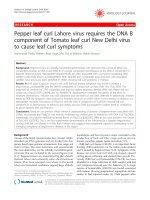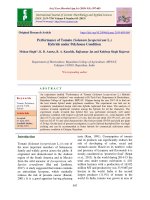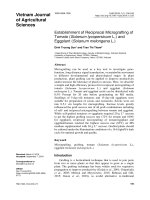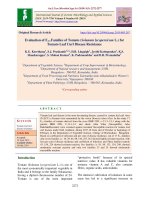Evaluation of F2:3 families of tomato (Solanum lycopersicum L.) for tomato leaf curl disease resistance
Bạn đang xem bản rút gọn của tài liệu. Xem và tải ngay bản đầy đủ của tài liệu tại đây (494.09 KB, 6 trang )
Int.J.Curr.Microbiol.App.Sci (2019) 8(5): 2272-2277
International Journal of Current Microbiology and Applied Sciences
ISSN: 2319-7706 Volume 8 Number 05 (2019)
Journal homepage:
Original Research Article
/>
Evaluation of F2:3 Families of Tomato (Solanum lycopersicum L.) for
Tomato Leaf Curl Disease Resistance
K.G. Keerthana1, S.J. Prashanth1,2*, H.B. Lingaigh1, Jyothi Kattegoudar1, K.S.
Shankarappa3, S. Mohan Kumar4, K. Padmanabha1 and B.R. Premalatha5
1
Department of Vegetable Science, 4Department of Crop Improvement & Biotechnology,
5
Department of Natural resource and management, COH,
Bengaluru – 560 065, Karnataka, India
2
Department of Food Processing and Nutrition, Karnataka state Akkamahadevi Women’s
University, Vijayapura -586108
3
Department of Plant Pathology, COH, Bengaluru, – 560 065, Karnataka, India
*Corresponding author
ABSTRACT
Keywords
Tomato leaf curl
disease resistance
Article Info
Accepted:
18 April 2019
Available Online:
10 May 2019
Tomato leaf curl disease is the most devastating disease, caused by tomato leaf curl virus
(ToLCV) a Gemini virus transmitted by the vector Bemesia tabaci Gen. In this study 17
F2:3 families of tomato derived from the cross IIHR 2201 x C-13-1-2-1 along with the
parents IIHR 2201, C-13-1-2-1 and check Arka Vikas (Succeptible), Arka
Rakshak(Resistant) were screened against resistant/ Succeptible reaction for tomato leaf
curl disease under field condition, during 2017-18 from end of October to beginning of
February in the Department of Vegetable Science, College of Horticulture, Bengaluru.
Based on coefficient of infection and per cent of disease incidence, out of 17 F 2:3 families
only seven families i.e. 18, 29, 64, 88, 144, 253, 261 showed highly resistant reaction, with
less per cent of disease incidence and coefficient of infection, and Three families namely
43, 158, 224 showed resistant reaction, five families i.e. 81, 89, 133, 134, 248, showed
moderately resistant reaction and only two families 33 and 35 showed moderately
succeptible reaction.
Introduction
Tomato (Solanum lycopersicum L.) is one of
the most economically important vegetable in
India and it belongs to the family Solanaceae,
having a diploid chromosome number of 24.
Tomato is one of the most important
“protective foods” because of its special
nutritive value. It has valuable vitamins for
instance vitamin A and C, also contains
fibers, organic acids, antioxidants.
The intensive cultivation of tomatoes in some
areas has led to a significant increase in
2272
Int.J.Curr.Microbiol.App.Sci (2019) 8(5): 2272-2277
farmer’s income, but a complex of pests and
diseases threatens its production and
productivity. Tomato suffers from large
number of fugal, bacterial, nematode and
many viral diseases during its growth period.
Among the viral disease, tomato leaf curl
virus (ToLCV) is one of the most devastating
disease in tropical and sub tropical region.
In India, tomato leaf curl disease (ToLCD)
was first reported by Vasudeva and
Samraj(1948).This disease is transmitted by
whitefly (Bemisia tabaci G.), belongs to the
genus Begomovirus of Geminiviridae family
of the order homoptera (Haydar et al., 1990;
Louro et al., 1996 and Morgan and Macleod,
1996). Tomato leaf curl virus infected plants
produce disease symptoms like clearing of
veins, reduction in leaf size, stunted growth,
deformation of leaf lets, inward and outward
curling and puckering of leaflets. The infected
plants produced only few fruits in case of late
infection and no fruits, at very early stage of
infection. The diseased plants usually
developed purple patches especially on older
leaves, ToLCV can reach up to 100 per cent
incidence with yield losses often exceeding
90 per cent (Vasudeva and Samraj 1948;
Sastry and Singh, 1973, Saklani and Mathai,
1977; Raychaudhary and Nariani, 1977;
Capoor, 1981; Saikia and Muniyappa, 1989).
Disease intensity was highly influenced by
the vector population and also climatic
condition like temperature, humidity and
rainfall. In Karnataka 90-100 per cent of plant
was infected with ToLCD during February to
end of May and from July to November per
cent of disease incidence is low due to fall in
whiteflies population brought about by low
temperature (Saikia and Muniyappa, 1989).
To achieve this goal the breeder has the
option of selecting desirable genotypes in an
early generations, when progenies are nearly
homozygous. In early stages of breeding
programmes, direct estimates of ToLCV
resistance, yield and other component traits
are quite difficult. Ahmad et al., (2016)
reported that tomato yellow leaf curl virus
disease (TYLCV) is one of the main factors
responsible for yield loss up to 100 per cent in
tomato as compared to other diseases,
therefore serious attention should be given to
screen resistant lines from F2 and F3
generations against TYLCV disease. Keeping
this background the present study was
formulated to determine the level of
resistance/susceptibility in F2:3 populations by
evaluating F2:3 families in open field condition
under natural screening.
Materials and Methods
The experiment was carried out at college of
Horticulture, Bengaluru during 2017 from
October end to beginning of February for
screening of F2:3 segregating population of
tomato for tomato leaf curl disease resistance.
30 days old healthy seedlings of seventeen
F2:3 families of tomato derived from the cross
IIHR 2201 x C-13-1-2-1 along with the
parents IIHR 2201, C-13-1-2-1 and checks
Arka Vikas (Succeptible), Arka Rakshak
(Resistant) were transplanted in paired row
system by following a spacing of 90 x 60cm.
In each family 40 plants were maintained and
total of 840 plants were planted for taking
observation. Incidence of ToLCD infection
and symptom severity was recorded at fifteen
days interval after transplanting in the field.
Symptom severity was recorded at 0-4 scale
on each genotype as suggested by Banerjee
and Kalloo (1987), Table 1. Per cent of
disease incidence was calculated using the
formula.
Total number of
infected plants
X
Per cent ToLCD
Total number of 100
incidence (%) =
plants observed
2273
Int.J.Curr.Microbiol.App.Sci (2019) 8(5): 2272-2277
17.50, 10.00, 22.50, 12.50, 10.00 per cent
respectively (Table 2).
Results and Discussion
Results obtained from the evaluation study of
F2:3 families for tomato leaf curl disease
resistance had shown that, the plant exhibits
resistant reaction at different growth stages of
plant. Some plant exhibit resistant reaction
during its initial growth, later become
susceptible i.e. during fruiting period, and
some plants are susceptible from initial stages
itself.
The results obtained from the experiment
revealed that parents IIHR 2201 and C-13-12-1 showed highly resistant reaction with low
per cent of disease incidence 7.5 and 10.00
and coefficient of infection 0.00. Checks Arka
Rakshak showed highly resistant reaction
with disease incidence of zero per cent and
coefficient of infection 0.00. Arka Vikas
showed susceptible reaction with disease
incidence of 62.5 per cent and co efficient of
infection of 56.87 (Table 2).
Out of 17 F2:3 families only seven families i.e.
18, 29, 64, 88, 144, 253, 261 showed highly
resistant reaction with coefficient of infection
2.41, 3.60, 2.62, 1.80, 3.60, 1.95, 1.60 and per
cent of disease incidence of 12.50, 15.00,
Five families i.e. 81, 89, 133, 134, 248,
showed moderately resistant reaction with the
per cent disease incidence of 25.00, 37.50,
25.00, 35.00, 37.50 and coefficient of
infection of 10.00, 15.46, 10.00, 15.05, and
17.81 respectively. The families 43, 158 and
224 showed resistant reaction with coefficient
of infection 6.18, 8.35, 6.32, and per cent of
disease incidence 22.50, 20.00, 27.50. Only
two families 33 and 35 showed moderately
susceptible reaction with the per cent disease
incidence of 37.50, 45.00 and coefficient of
infection 21.56, 26.41 (Table 2).
In the F2:3 segregating population, showed
segregation for hypocotyl colour of the plants,
i.e. purple and green. Plants with purple
hypocotyl color showed maximum per cent of
disease incidence compared to the plants with
green hypocotyl color. This indicates it can be
used as one of the morphological marker in
selecting the resistant plants. This finding is
Similar with the report of Thangam and
Veeraragavathatham (2006).
Table.1 The disease severity was scored as described by (Banerjee and Kalloo, 1987)
Symptom
Score
Response
Value
Coefficient of
infection
Reaction
Symptoms absent
0
0
0-4
Highly resistant (HR)
Very mild curling up to 25%
1
0.25
5-9
Resistant (R)
Curling, puckering of 26-50%
2
0.5
10-19
Moderately resistant (MR)
Curling, puckering of 51-75%
3
0.75
20-39
Moderately susceptible (MS)
Severe curling, puckering>
75%
4
1.00
40-69
Susceptible (S)
70-100
Highly susceptible (HS)
2274
Int.J.Curr.Microbiol.App.Sci (2019) 8(5): 2272-2277
Table.2 Reaction of F2:3 families of IIHR 2201 x C-13-1-2-1 their parents and checks for Tomato
leaf curl disease incidence
Sl. No.
Families
Per cent of disease
incidence(PDI)
Coefficient of
infection(CI)
Reaction
1.
18
12.50
2.41
HR
2.
29
15.00
3.60
HR
3.
33
37.50
21.56
MS
4.
35
45.00
26.41
MS
5.
43
22.50
6.18
R
6.
64
17.50
2.62
HR
7.
81
25.00
10.00
MR
8.
88
10.00
1.80
HR
9.
89
37.50
15.46
MR
10.
133
25.00
10.00
MR
11.
134
35.00
15.05
MR
12.
144
22.50
3.60
HR
13.
158
20.00
8.35
R
14.
224
27.50
6.32
R
15.
248
37.50
17.81
MR
16.
253
12.50
1.95
HR
17.
261
10.00
1.60
HR
18.
IIHR -2201
7.50
0.00
HR
19.
C-13-1-2-1
10.00
0.00
HR
20.
Arka Vikas
62.50
56.87
S
21.
ArkaRakshak
0.00
0.00
HR
HR- Highly resistant
MS- Moderately susceptible
R- Resistant
S – Susceptible
2275
MR- Moderately resistant
Int.J.Curr.Microbiol.App.Sci (2019) 8(5): 2272-2277
Fig 1.Tomato leaf curl disease symptom severity in F2:3 segregating population of IIHR 2201 x
C-13-1-2-1 (Plant number 253-13), 0: Symptoms absent; 1: very mild curling (up to 25%
leaves); 2: curling and puckering of 26-50 % leaves; 3: curling and puckering of 51-75 % leaves;
4: severe curling and puckering of >75 % leaves.
0
1
4
3
In conclusion, families 18, 29, 64, 88, 144,
253 and 261 exhibited highly resistant
reaction with less per cent of disease
incidence and coefficient of infection. The
resistant line can be used in the further
breeding programme to develop resistant
varieties and screened for the resistant gene.
References
Ahmad, M., Gul, Z., Iqbal, M., Khan, B. A.,
Khan, Z. U., Shahid, M. and Rehman,
A., 2016, Comparative study of effect
2
of TYLCV and septoria blight on F3
tomato lines. Int. J. Bio., 8(5): 229-235.
Banerjee, M. K. and Kalloo, G., 1987,
Sources and inheritance of resistance to
leaf curl virus in Lycopersicon, Theor.
Appl. Genet., 73:707-710.
Capoor, S. P., 1981, Important virus diseases
of field and garden crops in India and
their control. ICAR, New Delhi, pp. 44.
Haydar, M. F., Afifi, F. M. L. and Aly, F. A.,
1990, A simple approach for the
management of white fly borne virus
diseases on tomatoes. Bull. Facul.
Agric. Univ. Cario., 41 (3): 649-664.
2276
Int.J.Curr.Microbiol.App.Sci (2019) 8(5): 2272-2277
Louro, D., Noris, E., Veratti, F. and Accotto,
G. P., 1996, Firstreport of tomato
yellow leaf curl virus in Portugal. Plant
Dis., 80(9): 1079.
Morgan, D. and Macleod, A., 1996, Assessing
the economic threat of Bemisia tabaci
and tomato yellow leaf curl virus to the
tomato industry in England and Wales.
Pests Diseases, 3: 1077-1082.
Raychaudhary, S. P. and Nariani, T. K., 1977,
Virus and mycoplasma diseases in
India. Oxford and IBH publishing
Company, New Delhi, 102 pp.
Saikia, A. K. and Muniyappa, V., 1989,
Epidemiology and control of tomato
leaf curl virus in southern India. Trop.
Agri., 66(4): 350-354.
Saklani, U. D. and Mathai, P. J., 1978, Effect
of insecticides on leaf curl incidence of
tomato. Pesticides. 12(8): 17-20.
Sastry, K. S. M. and Singh, S.J., 1973,
Assessment of losses in tomato by
tomato leaf curl virus. Indian J. Myco.
Plant Path., 3: 50-54.
Thangam, M. and Veeraragavathatham, D.,
2006,
Reaction
of
segregating
populations for tomato leaf curl virus
(TLCV)
resistance
by
artificial
screening in tomato. Veg. Sci., 33(1):
98-100.
Vasudeva, R. S. and Samraj, J., 1948, A leaf
curl disease of tomato. Phytopath., 38:
364-369.
How to cite this article:
Astha Chaurasia, Shobha Jawre, Randhir Singh, Apra Shahi, Rekha Pathak,, Babita Das and
Naveen Kumar Verma. 2019. Evaluation of Haemato-Biochemical Parameters using Different
Biomaterials in Fracture Healing of Dogs. Int.J.Curr.Microbiol.App.Sci. 8(05): 2272-2277.
doi: />
2277









